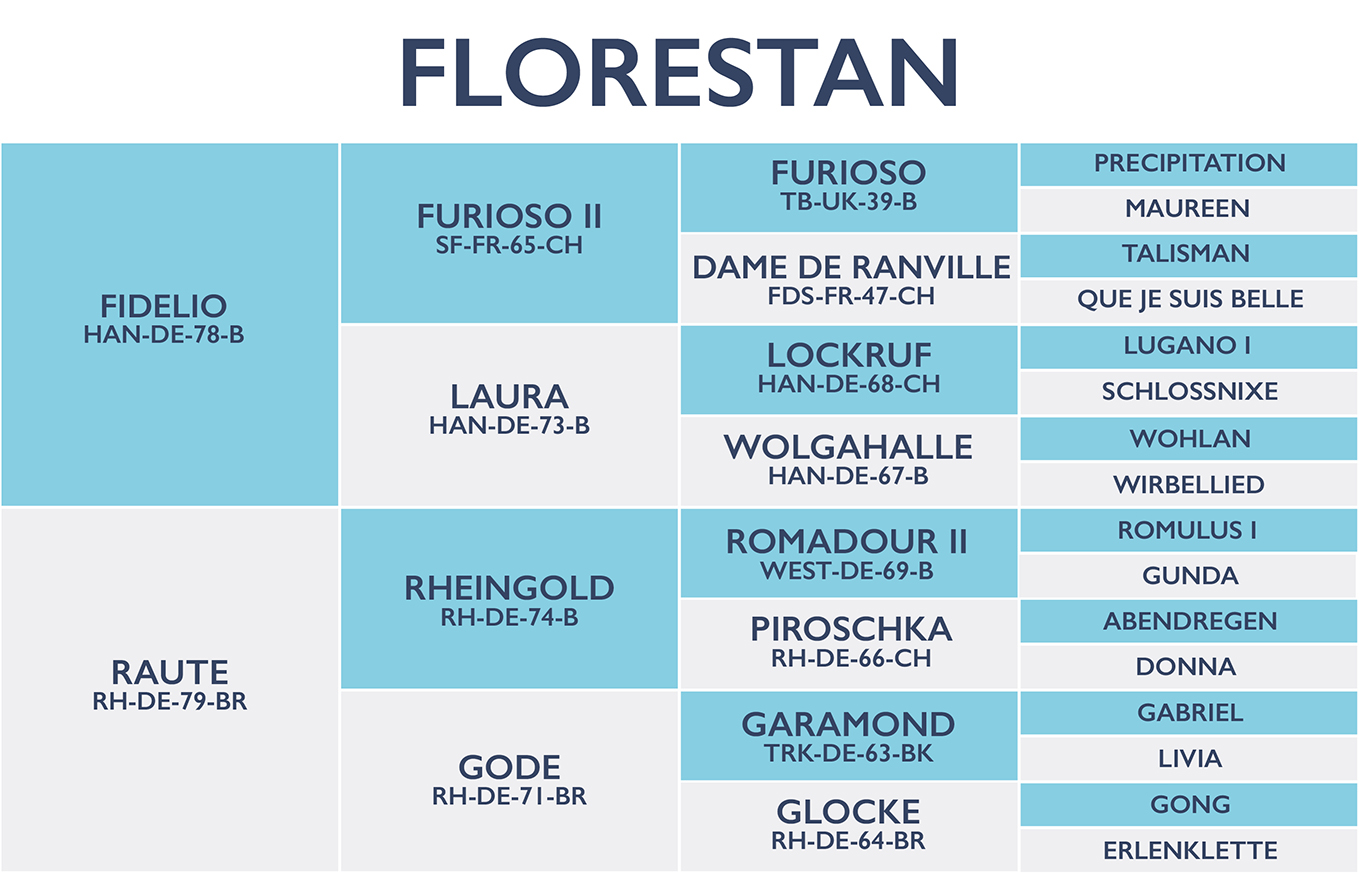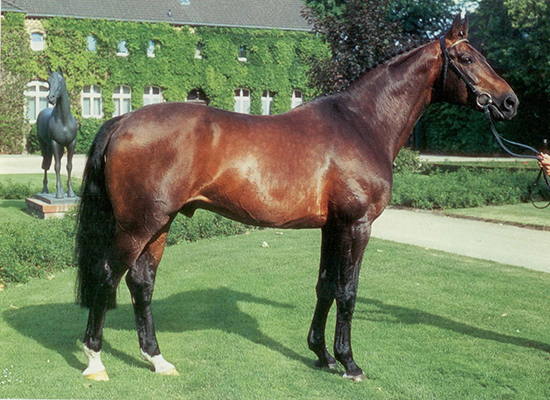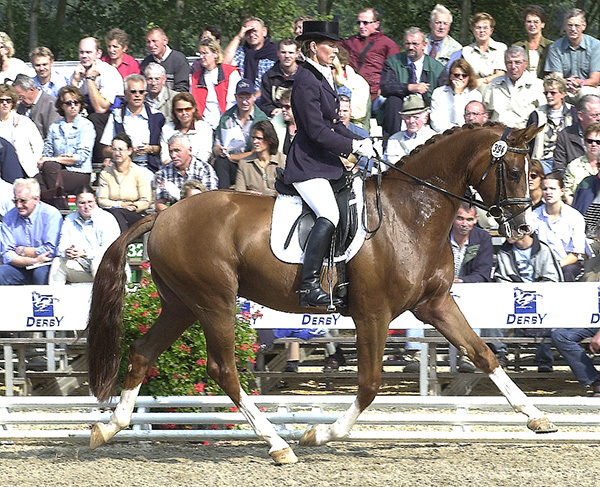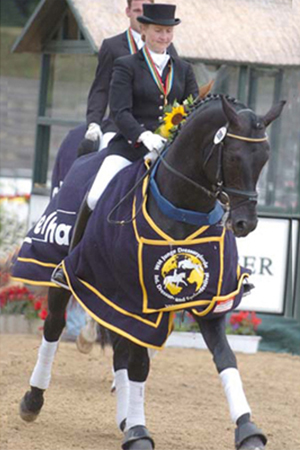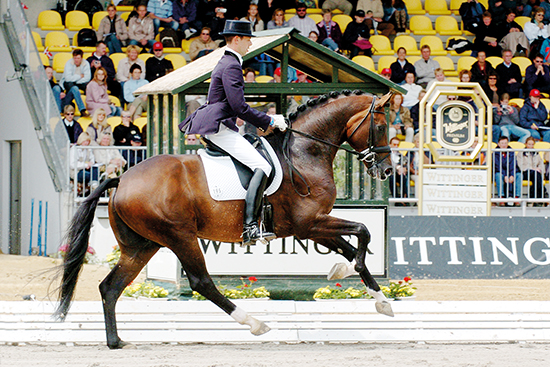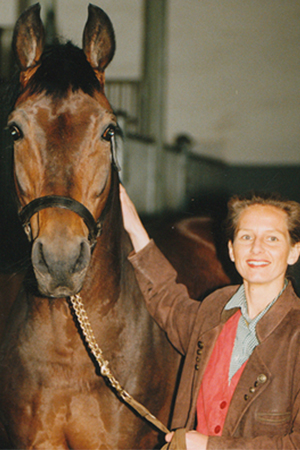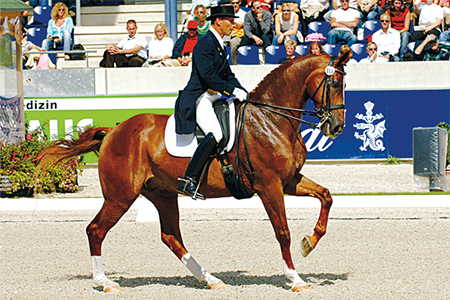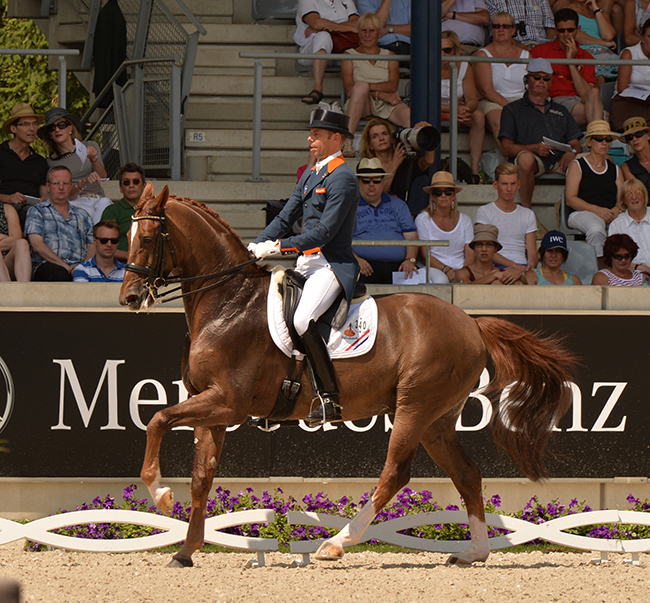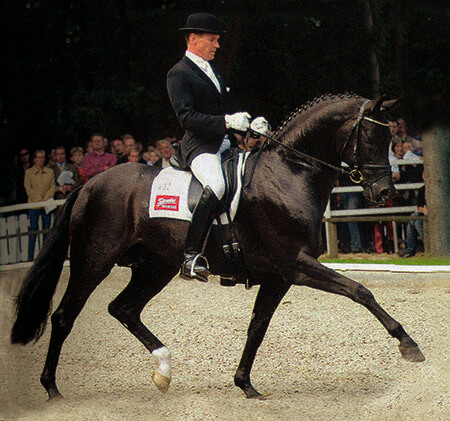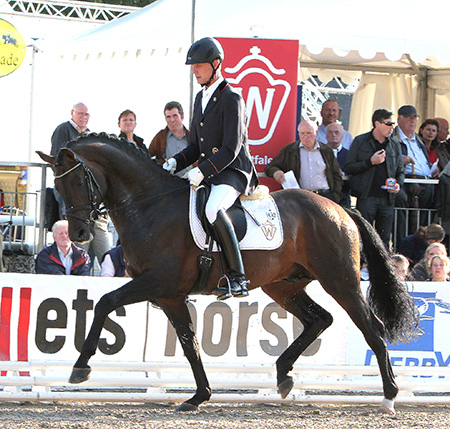1986 – 2012 170 cm Bay
There seems little doubt that the most influential dressage sire of them all has been the Selle Français import to Oldenburg, Furioso II – and most of that influence has flowed from his grandson, Florestan.
Of the twenty top dressage sires in the 2021 Hanoverian Stallion book, seven descend from Furioso II, all of them via Florestan with two more sitting in 21st and 22nd – Fürstbischof (Fürst Romancier / Plaisir d’Amour) and Fidertanz (Fidermark / Frühlingstraum II).
It was lucky for the future of Westfalien breeding that Florestan’s breeders, Grit and Eberhard Schulte-Böcker are traditionalists, the sort of breeders who prefer the honour of having a stallion in the State Stud, rather than a pile of Yankee dollars. They were offered big money for the young stallion, but preferred to see him go to Warendorf.
Florestan’s sire Fidelio was for many years a popular sire in the Rhineland, where he spread the rich genetic heritage of his Selle Français sire, Furioso II. His progeny included 136 registered mares, of whom 26 were awarded a States Premium. He also produced successful performers in both the jumping ring and the dressage arena.
Florestan’s dam, Raute was a successful show mare, and at the age of three was champion mare of her age group. In 1983 she won her class at the German Mare Show in Verden. In 1986 she was crowned Young Broodmare Champion at the National Broodmare Show in Verden, beating representatives from all over Germany. Aside from Florestan, Raute produced three States Premium mares: Wachtel (by Worldchamp), Palucca (Paretti) and Wapita (Worldchamp). The full brother, Florestan II stood at Warendorf but not with his older brother’s degree of success.
Raute was by Rheingold, who sired Rheinfee, the First Reserve at the DLG show, Rheinfee was the dam of the top stallion, Ehrentusch.
Raute’s grandsire is the Trakehner, Garamond, a noted producer of dressage horses. Florestan has further Trakehner blood through his sire’s dam line, since Rheingold is out of a mare by the Trakehner, Abendregen.
The grand dam is the state premium mare, Gode, a full sister to the Warendorf state stallion, Gardist. Gode competed up to Intermediate level before commencing a breeding career. Her daughter, Parodie (by the Trakehner, Pasternak) was again a successful dressage and the dam of a number of successful horses, including the mare Fidelity (by Fidelio) who in turn produced Fair Play, the dam of Waldrose, the dam of the 2002 Champion of the Three Year Old Riding Horses at the Bundeschampionate – Fürst Fabio, who is of course, by Florestan’s son, Fidermark.
Fürst Fabio, a winner as a two-year-old, by Fidermark by Florestan
Florestan I was champion of the 1988 Rhineland approval and won his performance test in Warendorf the following year. Initially Florestan was despatched to Bad Sassendorf, where he covered his mares live, and therefore didn’t produce many foals in his first few seasons. Florestan had critics who suggested that he was ‘just a pretty face’ but his first crops of foals won them over – and in 1996, he was transferred to the Central Insemination Station at Warendorf, where he was based for the rest of his life.
Florestan I has sired almost a thousand registered broodmares, 190 of whom have been awarded a States Premium.
He is also the sire of over 80 approved sons, including Fidermark, a four-year-old champion at the Bundeschampionate and a Grand Prix performer, now sadly deceased. The mare, Ferrara won the five-year-old class at the Bundeschampionate and went on to compete at Prix St Georges level with Isabell Werth. At the 2002 Bundeschampionate, Florestan had five representatives including the 4-year-old stallion winner, French Kiss.
A world title for Katrin Burger and the Florestan son, French Kiss
French Kiss went on to win the World Young Dressage Horse championship for 6 year olds in 2004 while another Florestan son, Florencio won the 5-year-old title at the same Championships!
Florencio winning at the World Young Horse Show with Hans Peter Minderhoud
Florencio followed up his victory in the World Young Dressage horse five-year-old championships with a win in the six year old championship the following year. Florencio had a promising beginning to his career as a breeding stallion. His first crop fetched extremely high prices at a number of top foal auctions. One of his foals won the 2006 German Foal Championship, and on the basis of his progeny he was given a Main Premium award. Six sons from his first crop have been licensed, including the premium colt, Fontane.
Here is what the former head of the State Stud at Warendorf, Susanne Schmitt-Rimkus has to say about Florestan, the stallion she affectionately calls ‘our milk cow’, in an interview I conducted in 2002:
“What makes a sire special is that he makes more good foals than bad ones – and that he improves on the mare, and Florestan has a very large percentage of good foals. Of course he has some which are not, but he is a ‘stamp’ stallion, he stamps his foals, nearly all of them have the type of their sire, you can recognize them. Here comes a foal – ‘oh a Florestan!’ This is something that makes it easier for a sire.”
“The other thing is that the Florestans are easy to handle, easy to ride, even if they don’t look harmonic, the riders say they feel good. This is the most important thing for the normal market, the rider who wants to ride of an evening after he has done his work, who wants to have fun, who wants to make a good picture on the horse. Florestans are easy to sit on, and that makes success.”
“Florestan will also produce top sport horses. Top sport horses have to have a good character but they are allowed to be more sensitive and so I think the good sport horses from Florestan will come from the mares with a lot of Thoroughbred blood – horses that are a bit more hot, these will be the horses for the highest competitions. But Florestan has many other horses for the levels A, L and M and that makes many riders happy. He has the best chance of producing the top horses because he gets the best mares.”
“There are some sires who should have the same chance but they don’t get it. Some people ask where are all the Florestans in the sport, like the Rubinsteins for example, but they forget that Florestan has only been in the artificial insemination program for six years. So his first foals from this are five years old now. Before that he was in natural covering and he didn’t have many mares. The people should wait a few more years and they will see the Florestans on Level S – I hope so, but we can’t influence that, nature will show it.”
A Grand Prix competitor, Floriano with Steffen Peters
The 2021 edition of the Hanoverian Stallion Book records that Florestan has had 1723 competition horses for winnings of €2,403,689. There were 1447 dressage competitors (207 to S level) and 383 jumpers – there are even 70 eventers. He has a Hanoverian breeding value of 124 for dressage, 90 for jumping, and 115 for type. Florestan’s 2021 FN dressage rating as a producer of young dressage horses is 127, but his highest level achieved value is 152.
He has produced 29 dressage with winnings of more than €10,000. The most successful was Fabriano with €88,213 followed by Forest Gump NRW with €68,967.
On the WBFSH dressage stallion rankings for 2011, Florestan was in 2nd place with sixteen representatives, the most successful of whom was Hiscox Artemis.
He was 6th on the 2015 WBFSH rankings, with his most successful competitor, Glock’s Flirt (Gauguin de Lully). On the 2016 WBFSH list, he was in 7th place with 12 competitors, easily the most successful of which was Glock’s Flirt.
On the 2017 WBFSH rankings, he has dropped to 9th, with Glock’s Flirt still his leading representative. By the 2018 rankings he was down to 54th. On the 2021 rankings, Florestan has dropped to 89th, his grandson, Fidertanz is ranked 6th, while Florencio is in 19th.
Glock’s Flirt and Hans-Peter Minderhoud
Florestan is the sire of 22 licensed sons, the best of whom have been Fidermark, Florencio and Fürst Heinrich.
I caught up with Susanne Schmitt-Rimkus at the 2011 Bundeschampionate.
When I first interviewed you, you have just been appointed to head the Stud in Warendorf, at that time I got the impression that Florestan was regarded as a good all-round horse, but now we are seeing the F line is a strong competition bloodline for dressage at the highest level…
“Yes, that’s right. I think what has happened is that the breeders have learnt how to breed with Florestan. The breeders who had good mares with a high potential for sport, but maybe a bit hot, they took Florestan, and planned a horse like this. So we have a lot of F line horses that have a bit hot mother lines, and then this F blood, can make very good sport horses.”
The Oldenburg breeders lost the F line for a while when the blood of Furioso II disappeared into Westfalia – have you lost your F line again? Some of the most exciting F stallions are now standing outside of Westfalia?
Fürst Heinrich, promising, but died young. Here with Holga Finken
“We lost some very interesting sons of Florestan, Fidermark was a really big loss, and over the years we more and more realize, how big this loss was. Fortunately he was used a lot when he was alive and we have very many good mares, and Fidermark blood on the mother line is as valuable as directly on the father line – so we have some good horses with Fidermark dams. Also Fürst Heinrich was a big loss because we see today, very good Fürst Heinrich children, and he was also a good sire of sires. Some of his sons look like becoming good stallions.”
Which are the most important F stallions in the Westfalian stallion group?
“We are still testing one of the younger stallions with a very high potential, First Selection, a son of First Final and this is a son of Fürst Heinrich – and his mother is by Fidermark. You can double this blood. Usually I am a bit critical of breeding this close, but with the F line you can do it without a big danger. The lines are a bit away – Fidermark and First Final are not directly related. It is a very good family in the background, his mother was one of the best mares in the performance test at the age of three. First Selection had his first foals this year, so we have to wait and see how they will be under saddle, but they were very good as foals.”
First Selection at the Bundeschampionate
“Then one of the very popular stallions who has found his place is Fürst Piccolo. He is a small stallion and when he was young people were unsure whether he would have such a great breeding career, but he has – he has lots of successful progeny competing up to S level now. At the moment he is the most famous F line stallion that we have.”
At the 2011 Bundeschampionate, I did an analysis of the competitors in the five year old dressage class. The results are a measure of Florestan’s success as a sire.
The average score for trot of the 59 competitors, was 8. The eight ‘F’ line horses, had an average trot score of 8.5; the nineteen ‘S’ line entrants an average of 8.15; the thirteen ‘D’ line horses, an average of 7.69, and the eight ‘R’ line horses an average of 7.6.
The average score for walk was 7.5. Once again the Florestan line comes out on top with a walk average of 8. Next best, the descendants of Donnerhall, 7.73 followed by the Rubinstein line with 7.44, and I guess it is no surprise to find the Sandro Hit line rated last for walk with an average of 7.24.
The average canter score was 7.7. Once again, the ‘F’ line comes out on top with an average of 8. The ‘R’ horses averaged 7.81, followed by the ‘D’ line on 7.65, then the ‘S’ line with a 7.63 average.
